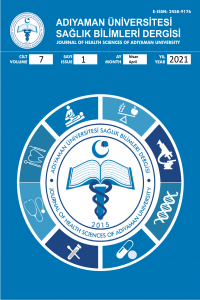Ayak Bileği İmpingement Sendromu Olgularında Direkt Grafi ve Manyetik Rezonans Görüntüleme Bulgularının Kontrol Grubu ile Korelasyonu
Ayak bileği, impingement sendromu, Manyetik Rezonans Görüntüleme, Direkt Radyografi
Correlatıon Between Direct Graph And Magnetic Resonance Imaging of Control Group and Ankle Impıngement Syndromes
Ankle, impingement, Magnetic Rezonance Imaging, Radiography,
___
- 1. Henderson I, Valette DL. Ankle İmpingement: Combined Anterior and Posterior İmpingement Sydrome of the Ankle. Foot Ankle Int. 2004 Sep;25(9):632-8.
- 2. Tol JL; Verhagen RAW; Krips R et al. The Anterior Ankle İmpingement Syndrome: Diagnostic Value of Oblique Radiographs. Foot Ankle İnt 2004 Feb;25(2): 63-68.
- 3. Robinson P, White LM, Salonen DC, et al. Anterolateral Ankle İmpingement: MRI Arthrographic Assessment of the Anterolateral Recess. Radiology 2001; 221(1); 186-190. 4. Farooki S, Yao L, Seeger LL. Anterolateral İmpingement of the Ankle: Effectiveness of MRI İmaging. Radiology 1998; 207: 357-360. 5. Robinson P, White LM. Soft-Tissue and Osseous İmpingement Syndromes of the Ankle: Role of Imaging in Diagnosis and Management. Radiographics 2002; 22(6);1457-1471.
- 6. Stoller DW. Magnetic Resonance Imaging in Orthopaedics and Sports Medicine 1997.
- 7. Rosenberg ZS, Beltran J and Bercardino JT. MRI İmaging of the Ankle and Foot.Radiographics, 2000; 20; S153- S179. DOI:10.1148/radiographics.20.suppl_1.g00oc26s153
- 8. Cerezal L, Abascal F, Canga A, et al. MRI İmaging of Ankle İmpingement Syndromes. AJR Am J Roentgenol. 2003 Aug;181(2):551-559. 9. Tol JL, Verheyen CPPM, Van Dijik CN. Artroscopic treatment of anterior impingement in the ankle; a prospective study with a five to eight year follow up. J Bone Joint Surg Br 2001; 83(1); 9-13.
- 10. Schweitzer ME, Leersum M, Erhlich SS et al. Fluid in Normal and Abnormal Ankle Joints: Amount and Distributions as seen on MRI images. AJR Am J Roentgenol. 1994 Jan;162(1):111-4.
- 11. 11. Schwitzer ME, Magbalon MJ, Fenlin JM et al. Effusion Criteria and Clinical Importance of GlenohuMRIeal Jonint Fluid: MRI Imaging Evolution. Radiology. 1995 Mar;194(3):821-4.
- 12. 12. Tol JL, van Dijk CN. Etiology of the Anterior Ankle İmpingement Sydrome: A Descriptive Anatomical Study. Foot Ankle Int. 2004 Jun;25(6):382-6. 13. Donald Resnick. Talar Ridges, Osteophytes and Beaks: A Radiologic Commentary. Radiology. 1984 May;151(2):329-32.
- 14. Berberian WS, Hecht PJ, Wapner KL et al. Morphology of Tibiotalar Osteophytese in Anterior Ankle İmpingement. Foot Ankle Int. 2001 Apr;22(4):313-7.
- 15. Bureau NJ, Cardinal E, Hobden R, et al. Posterior Ankle İmpingement Syndrome: MRI İmaging Findings in Seven Patients. Radiology. 2000;215(2):497-503.
- 16. Lee JW, Suh JS, Huh YM, et al. Soft Tissue İmpingement Syndrome of the Ankle: Diagnostic Efficacy of MRII and Clinical Results after Artroscopic Treatment. Foot Ankle Int. 2004 Dec;25(12):896-902.
- 17. Umans H. Ankle impengement syndromes. Semin Musculoskelet Radiol. 2002 Jun;6(2):133-39.
- 18. Liu SH, Raskin A, Osti L, et al. Arthroscopic teatment of anterolateral ankle impingement. Arthroscopy. 1994 Apr;10(2):215-8.
- 19. Masciocchi C, Catalucci A, Barile A. Ankle İmpingement Syndromes. Eur J Radiol. 1998 May;27 Suppl 1:S70-3. PM
- 20. Ferkel RD and Fischer SP. Progress in ankle arthroscopy. Clin Orthop Relat Res. 1989 Mar;(240):210-20. 21. Liu SH, Raskin A, Osti L, et al. Arthroscopic treatment of ankle impingement. Arthroscopy. 1994 Apr;10(2):215-8.
- 22. Beynnon BD, Murphy DF, Alosa DM. Predictive Factors for Lateral Ankle Sprains: A Literature Review. J Athl Train. 2002 Dec;37(4):376-380. 23. Stoller SM, Hekmat F, Kleiger B. A comparative study of the ferquency of anterior impingement exostoses of the ankle in dancers and nondancers. Foot Ankle. 1984. Jan-Feb; 4(4); 201-3. Foot Ankle. 1984;4(4):201-3.
- 24. Peterfy CG, Guermazi A, Zaim S, Tirman PF, Miaux Y, White D, et al. Whole-Organ Magnetic Resonance Imaging Score (WORMS) of the knee in osteoarthritis. Osteoarthritis Cartilage 2004.
- 25. John S, Mendicino RW, Catanzariti AR. Mastering Ankle Impinegement Syndromes. Podiatry Today. 2007.20 (8);52-60.
- Yayın Aralığı: 3
- Başlangıç: 2015
- Yayıncı: ADIYAMAN ÜNİVERSİTESİ
Ameliyathane Dışı Anestezi Uygulamalarımız. 3 Aylık Dönemdeki 2268 Hastanın Değerlendirilmesi.
Halime ÇEVİK, Necip Bülend SAYDAM
Hiperemezis gravidarum etiyopatogenezinde vitamin D eksikliğinin rolü var mı ?
Tuğba GÜRBÜZ, Nur DOKUZEYLÜL GÜNGÖR
D Vitamini ve Alzheimer Hastalığı
Murat AÇIK, Nurcan YABANCI AYHAN
Onur KILINÇ, Ayşe ATILGAN ÇELİK, Semra COŞKUN, Adem YILDIRIM
Üniversite Öğrencilerinde Yeme Tutumu Ve Yeme Tutumuna Etki Eden Faktörler
Safiye ÖZVURMAZ, Aliye MANDIRACIOĞLU, Emel LÜLECİ
Komplike İntraabdominal Enfeksiyonların Cerrahi Tedavi ve Sonuçlarının Analizi
Sabri ÖZDAŞ, Safa ÖNEL, Mehmet ŞİRİK
Metin ÇALIŞIR, Ahmet Cemil TALMAÇ
ÜNİVERSİTE ÖĞRENCİLERİNDE AKILLI TELEFON KULLANIMI VE BAŞ AĞRISI İLİŞKİSİ
